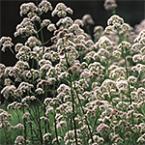Valerian

On this page:
Introduction
This fact sheet provides basic information about valerian—common names, what the science says, potential side effects and cautions, and resources for more information.
Valerian is a plant native to Europe and Asia; it is also found in North America. Valerian has been used as a medicinal herb since at least the time of ancient Greece and Rome. Its therapeutic uses were described by Hippocrates, and in the 2nd century, Galen prescribed valerian for insomnia. Today, valerian is used as a traditional remedy for sleep disorders and anxiety, as well as headaches, depression, irregular heartbeat, and trembling.
The roots and rhizomes (underground stems) of valerian are typically used to make supplements, including capsules, tablets, and liquid extracts, as well as teas.
What the Science Says
- Research suggests that valerian may be helpful for insomnia, but there is not enough evidence from well-designed studies to confirm this.
- There is not enough scientific evidence to determine whether valerian works for other conditions, such as anxiety or depression.
- NCCAM-funded research on valerian includes studies on the herb’s effects on sleep in healthy older adults and in people with Parkinson’s disease. NCCAM-funded researchers are also studying the potential of valerian and other herbal products to relieve menopausal symptoms.
Side Effects and Cautions
- Studies suggest that valerian is generally safe to use for short periods of time (for example, 4 to 6 weeks).
- No information is available about the long-term safety of valerian.
- Valerian can cause mild side effects, such as tiredness the morning after its use, headaches, dizziness, and upset stomach.
- Tell all your health care providers about any complementary health practices you use. Give them a full picture of what you do to manage your health. This will help ensure coordinated and safe care. For tips about talking with your health care providers about complementary and alternative medicine, see NCCAM's Time to Talk campaign.
Search the scientific literature for potential herb-drug interactions
Sources
- Awang DVC, Leung AY. Valerian. In: Coates P, Blackman M, Cragg G, et al., eds. Encyclopedia of Dietary Supplements. New York, NY: Marcel Dekker; 2005:687–700.
- Office of Dietary Supplements and National Center for Complementary and Alternative Medicine. Questions and Answers About Valerian for Insomnia and Other Sleep Disorders. Office of Dietary Supplements Web site. Accessed at ods.od.nih.gov/factsheets/valerian/ on June 3, 2010.
- Valerian. Natural Medicines Comprehensive Database Web site. Accessed at www.naturaldatabase.com on August 11, 2009.
- Valerian (Valeriana officinalis L.). Natural Standard Database Web site. Accessed at www.naturalstandard.com on August 4, 2009.
- Valerian root (Valeriana officinalis). In: Blumenthal M, Goldberg A, Brinckman J, eds. Herbal Medicine: Expanded Commission E Monographs. Newton, MA: Lippincott Williams & Wilkins; 2000:394–400.
For More Information
NCCAM Clearinghouse
The NCCAM Clearinghouse provides information on NCCAM and complementary health approaches, including publications and searches of Federal databases of scientific and medical literature. The Clearinghouse does not provide medical advice, treatment recommendations, or referrals to practitioners.
PubMed®
A service of the National Library of Medicine (NLM), PubMed® contains publication information and (in most cases) brief summaries of articles from scientific and medical journals.
Office of Dietary Supplements (ODS), National Institutes of Health (NIH)
ODS seeks to strengthen knowledge and understanding of dietary supplements by evaluating scientific information, supporting research, sharing research results, and educating the public. Its resources include publications (such as Dietary Supplements: What You Need to Know), fact sheets on a variety of specific supplement ingredients and products (such as vitamin D and multivitamin/mineral supplements), and the PubMed® Dietary Supplement Subset.
NIH National Library of Medicine's MedlinePlus
This publication is not copyrighted and is in the public domain. Duplication is encouraged.
* Note: PDF files require a viewer such as the free Adobe Reader.
